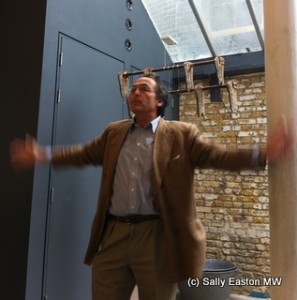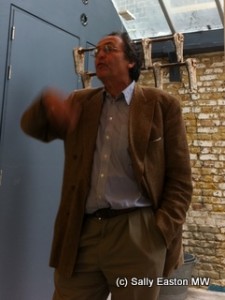Nicolas Joly on biodynamics
 At the first ‘natural wine’ fair held in London in May 2011, Nicolas Joly of La Coulée de Serrant in the Loire, gave a seminar about biodynamics. This is much of what he said:
At the first ‘natural wine’ fair held in London in May 2011, Nicolas Joly of La Coulée de Serrant in the Loire, gave a seminar about biodynamics. This is much of what he said:
“Scientists will tell you this is all rubbish, it has not been proved, but when you reach the level of taste, of smell, something which is not tangible, proof has no real meaning.
“Why does biodynamics play its part in the quality of wine? I start with taking an example: if you were in the vineyard in February, or the beginning of March, in the northern hemisphere, you will see nothing – pruned vines, small sticks with tiny buds. If you return to the same spot six months later, you have branches, leaves, flowers, grapes.
“In six months several tonnes of matter per hectare have appeared. If you take away water from that matter – to get dry matter – 94% of that dry matter comes from photosynthesis. This is a very important key to understand biodynamics. Photosynthesis converts the sun’s forces into matter. 94% of dry matter every year comes from photosynthesis.
“From spring to [autumn] a vine, a plant, is incarnating forces of something intangible, call it wavelengths or frequencies, into matter. Non-matter becomes matter. This is the key to biodynamics.
“When you say to people we use 10g, at most 100g, per hectare of biodynamic preparations, scientists say this rubbish. They say it cannot work, because this person has been trained in the physical way.
 “The main part of a plant is to take something intangible and to contract it into something tangible. The biodynamic preparations have to be viewed as catalysts.
“The main part of a plant is to take something intangible and to contract it into something tangible. The biodynamic preparations have to be viewed as catalysts.
“I describe biodynamics as being a better acoustic. [Imagine] a man with a splendid voice singing in subway [versus] singing in beautiful old church.
“So we help vines to catch a little deeper these forces which will become, in the end, taste and smell, structure and complexity in your glass. All this is intangible work, in the same way that if you see a beautiful painting, would you give it a score [out of twenty]? You cannot come up with measure for something that belongs to a non-physical world.
“So, with biodynamics, we try to help the soil to feed the root, and to help light and heat to feed the leaves. To help photosynthesis and help the work of the roots.
“You need to understand the forces to understand biodynamics. Gravity, which means contraction, are the forces that go to the centre of the earth. The opposite forces – sun attraction – are the ‘levitation forces’. Some biodynamic preparations work up, others work downward, some are in the middle.
 “You want an understanding of your place and an understanding of how you can balance these forces in the place where you live. And appellation contrôlée is a specificity of taste from the earth, and a specificity of taste from the climate, so we want to help the leaves catch the microclimate, and help the roots catch the micro-geology. And you want the vine to be as capable as possible to do this process (up and down).
“You want an understanding of your place and an understanding of how you can balance these forces in the place where you live. And appellation contrôlée is a specificity of taste from the earth, and a specificity of taste from the climate, so we want to help the leaves catch the microclimate, and help the roots catch the micro-geology. And you want the vine to be as capable as possible to do this process (up and down).
“A side effect of what I’m telling you here is that a clone is a nonsense. Clones have been invading the vine for 30 years and more. A clone takes one vine and makes lots of copies. It is absurd quality-wise. How do you create complexity? But clones are easy to manage because they all flower at same time, and are harvested at the same time. But they are missing the complexity that each vine wants to express.
“Once you understand that you want photosynthesis to be as good as possible, and the work of the root to catch the soil as well as possible, you want the vine to be as lively and as sensitive as possible.
“What has modern farming done to appellation contrôlée? First, weed killers, which destroy the life of the soil. Then the root cannot feed itself. Roots need the assistance of lot of microorganisms. Weed killers were presented to farmers in the late 50s, 60s. But after six or seven years the roots are starving so they grow back to the surface of the soil. Already the originality of the soil is destroyed.
 “Then you need to bring food, so chemical fertilisers came. They are like salt; chemical fertilisers force water into a plant. This is not growth. If you stopped chemical fertilisers, the world would starve because the soil is destroyed – chemical fertilisers have been replacing the soil. Vines are forced to grow because of the salty solution; it is forced to take up water.
“Then you need to bring food, so chemical fertilisers came. They are like salt; chemical fertilisers force water into a plant. This is not growth. If you stopped chemical fertilisers, the world would starve because the soil is destroyed – chemical fertilisers have been replacing the soil. Vines are forced to grow because of the salty solution; it is forced to take up water.
“Before weed killers and chemical fertilisers, the pressure of disease was lower, and we could solve diseases with simple products, such as copper and sulphur. If these are used in small quantities, these are not poisons.
“Then came systemics, where molecules go in the sap, so you are sure not to have diseases. But the side effect is it poisons the sap. So on one side the downward process of the root is killed by weed killer, and [on the other] the originality of climate is weakened by systemics. The result is a crop which is not marked by the originality of the place where the vine is growing.
“Once you understand this, you understand why organic wines are coming back, why biodynamic wines are spreading all over the world. A deeper understanding of nature, respecting nature allows good taste to be achieved. All biodynamics is, is stimulating forces which are specific to the place of the vineyard, which increase the originality of taste.
“In biodynamics what you have in front of you, the vine, is the incarnation, through photosynthesis, of forces transformed into matter between spring and [autumn].
“With biodynamic preparations in tiny quantities, we are improving specific processes. For example if you put black plastic around the earth, some sort of death will come. So we know life on earth depends on being a member of the solar system. What forces keep together the solar system? We don’t work at the physical level, we work with the forces that end up at the physical level.
“With pollution, only the physical pollution of the atmosphere is covered, not the energy pollution of the atmosphere. But if you fill the atmosphere with billions of frequencies and wavelengths, for example with satellites, antennae, you are weakening the forces that bring life to earth.
“Biodynamic preparations – we can call them Mr. potassium, Mr. calcium, Mr. phosphorus, Mr. iron – help to recreate a system of communication for the plant to receive the forces it needs to help it express itself [that help photosynthesis etc].
“You need to understand the light, heat and earth forces. Heat goes up – it destroys the earthly process [into gas]. Light goes with air. Water is the liquid state. No life on earth [exists] without going through the liquid state. Then there is the earthly level.
“Understanding polarities is what biodynamics is about. If you have a place where the earth is too strong, you can calm down the forces. And you can increase reception for other forces. If you have too much downward force – wine has no taste. Too much cosmic force – the vine will die. So need to balance it.
“Then you need to understand with these four levels of matter [heat, light, water, earth] what is each animal. Pig manure is linked to earth, so if you are in rocky place with shallow soil, with not enough earth forces, then bring pig manure. Horses are linked to heat. In a place like Champagne, which lacks heat, bring horse manure.
“By having a deeper understanding of nature, of the forces in each type of plant and animal, of the place where you are, the bottom or top of a valley; which aspect, once you know this, you will know how to use biodynamic preparations. … to allow the plant to express itself. Or to find for the singer the place with the best acoustic to express his voice.
“Then we reach the cellar. When we have 12 hours of day and night we have a balance of the down [gravitation] (autumn) and the up [sun attraction] spring [forces]. The day after spring, you have 1 minute more of day than night – the scale of balance has changed. All the forces are going outward. Then you have the flowering, the reception process. After summer, days are getting shorter, then the movement is a slow contraction into seed. If things are balanced, you have within the grape at the time of harvest everything in the grape that you need, to do nothing in the cellar. The opposite of what is taught in universities.
“So biodynamics is rediscovering the forces that are behind life. The behaviour and understanding of place through biodynamics allows vines to come up with more complex taste.”
Comments
3 Responses to “Nicolas Joly on biodynamics”




May 27, 2011 at 8:23 am
Gosh! While his aims are the same as many of us – keep the soils alive and attain balance in the vineyard – his view of how things work (AKA science) reads like a fantasy novel. The scary thing is that he slips in scientific terms like gravity, photosynthesis, wavelengths and catalysts without any true understanding of what they mean or what they do.
May 27, 2011 at 10:56 am
Certainly the words on the page don’t truly convey his passion and vivacity and his deeply thought-out views. Do the results of his work and philosophy – his wines – speak for themselves?
May 30, 2011 at 3:12 pm
Mr. Joly’s claim that taste and smell are not tangible shows his lack of understanding of chemical analysis – it is possible to identify and isolate the chemical components that produce taste and smell in wine. There are thousands of such possible components, and the work is difficult, but such successes as identifying two of the common chemicals producing cork taint (TCA, which is 2,4,6-trichloroanisole, and MDMP, which is 2-methoxy-3,5-dimethylpyrazine), which are bothersome at levels in the low nanogram per liter levels in wine, is a modern scientific accomplishment in tangibility. Of course, I am a scientist, and I agree with Jon Hesford – Nicolas Joly’s verbal fluff is scary.